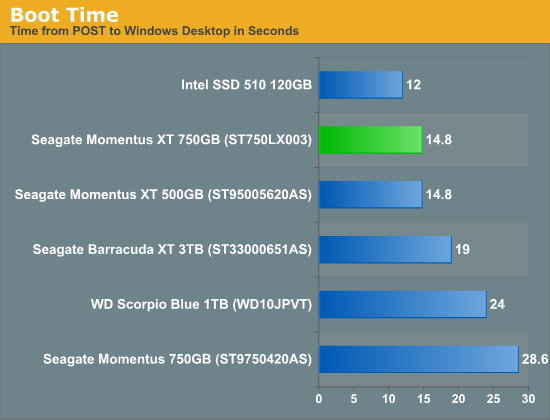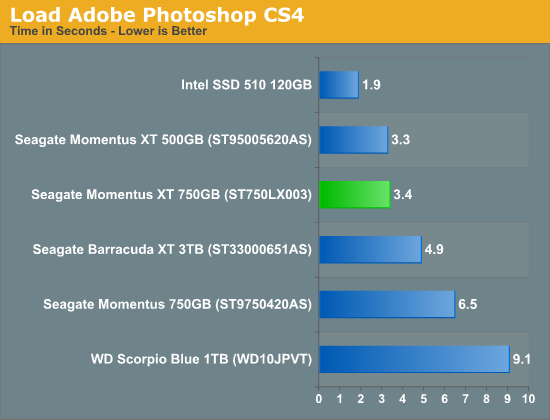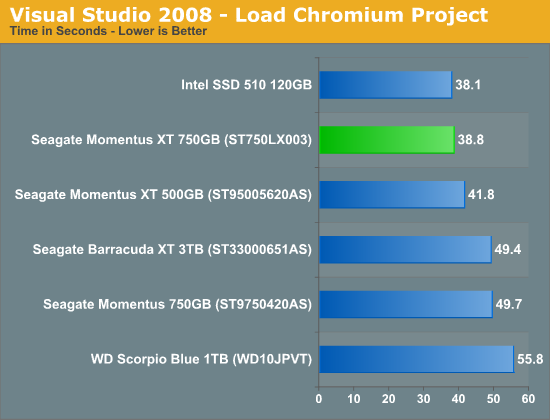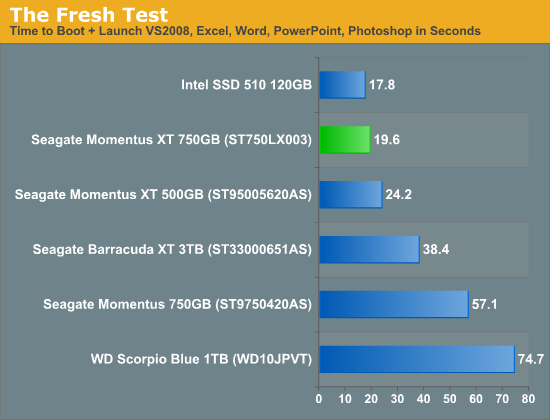Seagate 2nd Generation Momentus XT (750GB) Hybrid HDD Review
by Anand Lal Shimpi on December 13, 2011 12:51 AM EST- Posted in
- Storage
- Seagate
- Momentus XT
- Hybrid Drive
- HDDs
- SSHDs
Once More, With Feeling
Just as we did in our original Momentus XT review, we'll start with a look at some hand-timed application tests.
First up is a good old fashioned boot test. I measured boot time on our testbed from POST to first seeing the mouse cursor on the Windows 7 desktop. This isn't a timing of actual boot-to-use since more loading happens even after you get to the desktop, but it does encapsulate much of the Windows 7 boot process.
All tests were repeated until performance leveled off. In the case of an SSD, this was after just one run. In the case of the 500GB Momentus XT, it took five runs to get there, whereas the second generation model was there after just two. The traditional hard drives each took a few runs for their performance to stabilize as well due to Windows 7's own boot optimizations taking effect.

Boot performance continues to be very impressive on the Momentus XT. It's still not quite as fast as a high end SSD, but it's definitely faster than a traditional hard drive (even a faster, 3.5" model). With a larger NAND cache, your boot time is more likely to remain this low even as other applications and data are pulled into the cache.
Next let's look at a simple application launch test. Adobe Photoshop continues to be one of the more stressful workloads for a hard drive, even down to launching the application. Here I measured from the time I clicked on the Photoshop icon in the Start Menu to first appearance of the blank Photoshop canvas and toolbars. Again, I repeated this test until performance leveled off in all cases.
For the Momentus XT performance fluctuated and it never truly settled on a single launch time. Performance started out at over 5.6 seconds but for all runs after the 2nd launch time ranged in the upper 2s - upper 3s. For its results as well as those from all of the hard drives, I averaged five launch times and presented those averages. The lone SSD in this comparison delivered consistent performance across all runs.

Here the Momentus XT continues to do very well, for a hard drive. It's faster than any of our mechanical drives, and significantly faster than your run-of-the-mill 5400RPM 2.5" drive for sure. A good SSD is still around 70% faster than the Momentus XT.
When constructing our Visual Studio 2008 project build benchmark for our CPU reviews I was reminded just how much of a pain it is to do development work on a system with a hard drive. I tried using the same benchmark to measure drive performance however it seems I used too good of a CPU benchmark as disk performance plays a small role in actual compile time here. Instead I looked at the impact of disk performance on loading the Chromium project in VS2008. I used the same test rules as before, presenting performance once it has leveled off for all drives involved. Once again, the SSD delivered peak performance after a single run. The Momentus XT was able to do it after 2 - 3 runs. Performance didn't improve over multiple runs with the traditional hard drives.

There's a clear division between the NAND equipped Momentus XTs and the traditional hard drives here, but not so much between the former and the Intel SSD 510. I can definitely understand Seagate's temptation to draw the comparison to the performance of an SSD. The problem with doing this is highlighted in my comments above however. While the SSD always performed to the best of its abilities in our tests, regardless of the number of times I ran a test, the Momentus XT needed a couple of runs to get to that point. The NAND cache isn't overly predictive and as a result the first time you do almost anything the Momentus XT will perform like a traditional 7200RPM 2.5" hard drive. Given a light enough workload, the Momentus XT should be able to eventually fit much of the most frequently read data into its cache, but the process of actually getting there can still be painful.
For our last application level benchmark I turn to something I've used since the early days of SSD reviews: the fresh test. Take our boot test from earlier, and string together a series of application launches after you hit the desktop. In this case I'm launching Excel 2007, PowerPoint 2007, Word 2007, Visual Studio 2008 and Photoshop CS4 as soon as the system boots. I measure the time from POST until the last application is completely launched. I call this the fresh test because when you first build a machine everything, even on a traditional hard drive, performs quickly. Load up a lot of applications and use your system for a while and you'll soon notice that things aren't quite as snappy any more. Defragmenting your drive can help but after a certain point it's the bloat of everything installed that really limits performance. A better test would be to use an image that was months (if not years) old, but I've found that this benchmark gets the job done. Lower numbers here translate very well to a snappier system and one that feels new regardless of what you've got loaded on it. SSDs truly excel in the fresh test, but what about the Momentus XT?

Surprisingly enough, the Momentus XT does extremely well. The newer model clearly does a better job of keeping more data in NAND, but both are head and shoulders above the traditional hard drives. If you have a fairly regular usage pattern (E.g. you always run the same 5 or 6 applications), the Momentus XT can significantly improve the overall user experience. In some cases, it can even approach the performance of an SSD.










98 Comments
View All Comments
kyuu - Tuesday, December 13, 2011 - link
First of all, overall, a great review Anand.However, a few points:
1) The high price point is obviously because of the Thailand flooding that has affected all HDD pricing. If it wasn't for that, I'm quite sure the MSRP would be well south of $200 (not to mention the actual selling price, like the previous Momentus XT 500GB was going for $99 before the flooding, and sometimes even lower than that with specials). Not sure why this wasn't pointed out in the review.
2) Why oh why doesn't anyone ever address the market for these drives as a secondary HDD paired with a primary SSD? That's how I'm using my Momentus XT 500GB in my desktop setup, and it's been great. My SSD is not large enough to fit all my applications/games, so the ones that don't fit (like all my damn Steam games) go on the Momentus XT. Still miles better than a regular HDD, and much, much cheaper than buying more SSD capacity (or at least it was before HDD prices went through the roof). Doesn't hurt to have the performance for all my media files as well.
3) This isn't specifically at you, Anand, but at those saying these drives are pointless/underperforming/too expensive/whatever -- These drives beat the heck out of a Velociraptor and have pretty much obsoleted them. You get better performance in pretty much any real usage scenario with a lot less power, heat, and it's still way cheaper per GB. Further, I would recommend this drive to anyone I know with a laptop or who even to anyone putting together a desktop if they aren't savvy enough to deal with managing data between a small SSD and a larger HDD or if they're building a performance rig with an SSD + this drive as the secondary HDD for apps/games that don't fit and media -- once the price comes down, that is.
4) Anand, you said you got an early version of the firmware with write caching enabled. Any chance of getting some more details about your experiences with that? I would assume they'd set aside a small portion of the drive for write caching so it doesn't negatively affect the read caching too much.
5) You also failed to note the FAST Boot feature that actually sets aside a portion of the NAND for boot files so they are never expelled by other LBAs. Now, I'm curious about a couple things that maybe you could clear up with Seagate: first, how does this work with dual-boot setups (such as Windows/Linux on the same drive)? Second, what if this drive is used as a secondary HDD and it is not used for booting an OS? Is the NAND set aside basically wasted or is the controller able to recognize this and allow that NAND to be used for caching other data?
kyuu - Tuesday, December 13, 2011 - link
Oh, and --6) This drive would be a great upgrade for a PS3, methinks... again, once the price comes down (though again, it's the whole Thailand mess and the HDD market in general, not just this drive).
BPB - Tuesday, December 13, 2011 - link
From what I've seen of reviews elsewhere, the PS3 does not take advantage of any HDD faster than 5400RPM. Even a 7200RPM upgrade does little to nothing to effect performance, so you would be wasting your money. Just Google the idea and you'll see plenty of sites have tested it out.WeaselITB - Tuesday, December 13, 2011 - link
I'm also really curious about how this drive would compare in that scenario. I currently have a 128GB SSD boot drive in my desktop, and a crummy old 500GB drive for data. I'm really curious what the performance advantages / comparisons between this SSHDD and something like a traditional 7200rpm 2TB drive would be ... especially even more so in a RAID-0 or RAID-1 configuration.I do know that Seagate is also planning a new Barracuda XT 3.5" SSHDD, but haven't heard anything further on that since the initial annoucement in early November. I would love to know more about that scenario and drive as well.
Thanks!
-Weasel
Hrel - Tuesday, December 13, 2011 - link
So I saw 8GB of DDR3 on newegg today for 10 bucks. Which begs a couple questions, first how on earth can you justify 200+ dollars for 8GB of nand? I was under the impression nand was both slower and less expensive than RAM. So I do not understand the price at all.Second, if I can get 16GB of RAM for 20 bucks, why can't I just allocate that as a cache instead of using an SSD? I could easily put 32GB of RAM in my laptop and give 20GB or so to cache. I don't need more than 8GB of RAM for anything I do; ever, even HD video editing.
freezervv - Tuesday, December 13, 2011 - link
I think the simple answer is "OS compatibility".Neither Windows or Mac support this in any smoothly integrated way, to the best of my knowledge.
Yes, you could (can) do that, but what percentage of the market is able to? Vs. everyone can buy a "go faster" hard drive.
xSSei - Tuesday, December 13, 2011 - link
Totally different technologies. RAM is volatile memory (the moment you turn it off, all the data is lost, which makes the caching thing kinda useless if you gotta rewrite all the data to the flash when you boot it up) while NAND flash is non-volatile. The added fact that they use SLC flash, as opposed to MLC flash also makes it a bit more expensive, although I guess Seagate is trying to let their drives last as long as possible.Hrel - Tuesday, December 13, 2011 - link
I forgot about the volitility thing. You could still create tags to reload the most used info on boot; I almost never turn off my computer; RAM isn't cleared in sleep state so that'd be fine. I like that they use SLC, I just don't think it justifies a 750GB hdd costing more than 140 when I can get 2+TB for under 100 bucks.melgross - Tuesday, December 13, 2011 - link
SLC costs a good deal more than MLC, so there's that expense. Then there are different speed parts, just like RAM modules, so there's that dependency as well.Too many people make the mistake of looking at the lowest quality parts, and compare them to high performance parts and question the pricing.
Meaker10 - Tuesday, December 13, 2011 - link
How does this drive act in a raid0 configuration, does it break or do you see a benefit of more NAND in there?